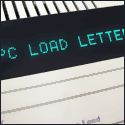|
If you find yourself having to adjust for a shrillness in EVERYTHING, regardless of its source, it may pay to check your monitoring situation.
|
|
|
|

|
| # ? May 10, 2024 20:27 |
|
What do you mean by that?
|
|
|
|
I AM NOT THE MOON! posted:What do you mean by that? Certain headphones or monitors may accentuate certain unpleasant frequencies, or you might have something in your chain that's causing unpleasant peakiness.
|
|
|
|
Or it could be room resonances.
|
|
|
|
So I'm having trouble figuring out Basic Channel/Maurizio sub-bass. Here's some examples: https://www.youtube.com/watch?v=Uv2Obf4tGRA https://www.youtube.com/watch?v=EckVABp2moI&t=195s https://www.youtube.com/watch?v=6iV4fKanfzM As far as I've gathered, it's a square/triangle wave (likely not a sine because of all of the harmonics). Then it's put through overdrive perhaps? Then heavily saturated? Compressed? So far my attempts have just given me a sub-bass that could work in a typical electronic song with bass (dubstep, bass music, etc), but it just doesn't have the punch. Even if I turn it way up and obliterate the headroom, it just mehs. I'm also open to use analog equipment - effect pedals, etc, in order to achieve this sound, since I have some equipment and I know that these songs were created with analog equipment.
|
|
|
|
I hear mostly square waves, without any real processing. Here's your first link re-done with a Minimoog; not a lot of resonance, cutoff all the way down, filter envelope amount set about halfway, a tiny attack lag, and decay set to give it a similar bounce bounce.
|
|
|
|
snappo posted:I hear mostly square waves, without any real processing. Here's your first link re-done with a Minimoog; not a lot of resonance, cutoff all the way down, filter envelope amount set about halfway, a tiny attack lag, and decay set to give it a similar bounce bounce. Ooh neat. That is really similar. I'll have to play with square waves for sure. Thanks!
|
|
|
|
RobattoJesus posted:I had a go at this sound because it seemed cool. Here's what I ended up with: I know this was a while ago. But I have not been able to get it still. The closest I got is still a ways away. This is what I have.  The pluck is too low pitched or something, and the tone still isn't right. I tried what you said but it didn't work very well. I have been trying to get it right for weeks but it still isn't close.
|
|
|
|
edit: Never mind, probably off the mark in comparing fx.
Tilde White fucked around with this message at 05:24 on Mar 2, 2014 |
|
|
|
I AM NOT THE MOON! posted:https://www.youtube.com/watch?v=EWqCGxm0e6Y Couple of things. There's a root D playing offbeats in the pattern, a bit quieter than the higher notes. Hard to hear distinctly, but that's what fills it out, and maybe why you can't tell if you're playing too low or high. Also, there are two different delay lines going: a (bpm 170) quarter note tap panned to the left and a 3/16 tap to the right, which gives it the back and forth sway. Waveform sounds to me like a single sawtooth, with a low cutoff, touch of reso, and a quick plucky filter+amp envelope. Here's my attempt, with some fairly drastic EQ bandlimiting (hp @ 250, LP @ 2750) and a big narrow boost around 875 Hz, which is where a lot of the energy in that sound lives. 
|
|
|
|
I am bad at figuring out FM synthesis. I'm trying to recreate the sound used in late 80s Williams pinball machines. Examples: https://www.youtube.com/watch?v=fCKDvjVzpNQ (tell me this doesn't get you fuckin' pumped to play some pinball) https://www.youtube.com/watch?v=W075Y1p3gAE https://www.youtube.com/watch?v=J38EqLOuFGw (This one was a bit later, may be different hardware) These are pretty similar instruments if not entirely identical. The Williams games of this era used the Yamaha YM2151, a 4-op FM synth that was pretty common in arcade games of the day; its bigger cousin made its way into the Genesis. I'm armed with most of the iPad synth apps, notably TF7 and DXi (a 4-op DX7 clone that's probably my best bet). I can get kiiiinda similar but not really there. Any ideas? Wish I were more familiar with figuring out FM sounds but no luck so far.
|
|
|
|
snappo posted:Couple of things. There's a root D playing offbeats in the pattern, a bit quieter than the higher notes. Hard to hear distinctly, but that's what fills it out, and maybe why you can't tell if you're playing too low or high. Also, there are two different delay lines going: a (bpm 170) quarter note tap panned to the left and a 3/16 tap to the right, which gives it the back and forth sway. Can you show me a picture of what you did, a visual reference could help me a lot when I try it again.
|
|
|
|
Eegah posted:I am bad at figuring out FM synthesis. When I tried figuring out FM, I used this guide: http://blackhole12.deviantart.com/art/Sytrus-Synth-Creation-Part-1-75704794 It is pretty useful in learning some basics, and has pictures of each step to make it a bit easier. Definitely one of the better guides I have seen for this.
|
|
|
|
I AM NOT THE MOON! posted:Can you show me a picture of what you did, a visual reference could help me a lot when I try it again. I did it on a Minimoog, but I'll download Synth1 tonight and see if I can screenshot a similar sound for you. The main component of the sound is the plucky filter envelope, where LP cutoff is set at or near 0, filter envelope amount is set just high enough to create the right level of brightness, with an instant attack, 0 sustain, and a short decay set by ear to approximate the length of the notes you hear in the example.
|
|
|
|
I'd be very interested in seeing that too, because I wanted to help out and hosed around with plucks in Synth1 all evening and couldn't get nearly that close. Now I'm wondering if that's because of my relative ineptitude or if the filter or envelopes of Synth1 just don't allow it. Got some pretty sweet sounds and the start of a new track in the process though.
|
|
|
|
Here you go. The envelope shape of Synth1 doesn't seem to lend itself quite as well to pluckies, but it can get you in the ballpark. Also including the EQ curve I applied, as well as a visual of the alternating MIDI pattern. Remember that the two panned delay lines (quarter note and 3/16 note) can't be done within the synth alone, you'll need to use one or more additional delay plugins to accomplish that.    
|
|
|
|
Ah, sweet. I was just starting out from the wrong osc shapes alltogether and did no eq'ing at all.
|
|
|
|
Probably an easy one.. I've been looking for this drum sound, I swear it's off some old drum machine but I haven't been able to find it. It's the higher pitched sound that starts within 5 seconds in this song. https://www.youtube.com/watch?v=klIXtwEKoeU
|
|
|
|
dr. blanky posted:Probably an easy one.. I've been looking for this drum sound, I swear it's off some old drum machine but I haven't been able to find it. It's the higher pitched sound that starts within 5 seconds in this song. [video] If it sounds too crisp, maybe make it 12bit/22KHz or something or use some other trickery to simulate it being run through various stages of sampling in a hardware sampler.
|
|
|
|
Edit: nevermind, figured it out
The Skeleton King fucked around with this message at 21:07 on Mar 5, 2014 |
|
|
|
I AM NOT THE MOON! posted:What is the name of that EQ? ReaEQ, the EQ for the program Reaper 
|
|
|
|
I AM NOT THE MOON! posted:What is the name of that EQ? EDIt: Well, don't I look like a fool.
|
|
|
|
I think someone actually asked about a similar sound in this thread before but I can't seem to find it. It's been in a lot of UK songs for the past few years. https://www.youtube.com/watch?v=SKh9BedNVR8 at 59secs. It sounds to me like a couple saw waves at different octaves played in a chord with some subtle phase modulation and a ton of unison and a slow attack and rising lowpass filter maybe? I just can't seem to get to get it right on though so maybe I'm missing something.
|
|
|
|
This feels like it should be an easy one, but it's giving me a hard time. https://www.youtube.com/watch?v=mZ-baSbryTc The synth line that starts right at the beginning of this track. Played around in Alchemy for a while trying to match it but there's something I'm not getting.
|
|
|
|
SaucyLoggins posted:I think someone actually asked about a similar sound in this thread before but I can't seem to find it. It's been in a lot of UK songs for the past few years. https://www.youtube.com/watch?v=SKh9BedNVR8 at 59secs. Try a single saw wave osc (no unison), rising volume and vibrato. edit: playing lots of notes, with the vibrato synced. If your synth doesn't do that, record it without vibrato and apply vibrato to the sampled line. wayfinder fucked around with this message at 23:56 on May 4, 2014 |
|
|
|
BKPR posted:This feels like it should be an easy one, but it's giving me a hard time. Take a square wave, filter-envelope it into a pluck and waveshape the gently caress out of it. That may work.
|
|
|
|
BKPR posted:This feels like it should be an easy one, but it's giving me a hard time. wayfinder has a good idea. my idea though would be to peak out a sine wave that has some filter and pitch envelopes, then map that peaked out sound to a sampler to play at a non-ear-ending volume. it sounds like there might be a little reverb on it too.
|
|
|
|
This thread is insane. I can't believe some of the poo poo you guys are able to recreate. I need help with 2 sounds. The first is the one which sounds almost like a phone busy signal in the intro/verse to this song: Spacehog - In The Meantime https://www.youtube.com/watch?v=TDkhl-CgETg And the sound which is in the verses to this (enters at 0:23 or so): 311 - All Mixed Up https://www.youtube.com/watch?v=JjTjtJDZomw Thanks!
|
|
|
|
HaB posted:This thread is insane. I can't believe some of the poo poo you guys are able to recreate. First sound: probably a simple square wave with a bit of white noise, high- and lowpassed together and possibly with a slight, slow vibrato. make sure the volume envelope is a perfect gate, without ramp-up (the sudden start is what can produce those clicks) Not sure what you mean in the second example... if it's the low slide-whistle, that could be approximated with a sinewave with a narrow, pitch-synced bandpass, overlayed with soft bright noise (think ffffffff instead of SHHHHHH). The signature here is in the portamento (also called glide in some synths) - set it to a relatively high value so that the notes slide into each other.
|
|
|
|
What are the basics of making drums for industrial?
|
|
|
|
Get yourself into a kitchen or factory or kitchen factory with a field recorder and start recording. Load the results in an older (90s or before) sampler and pitch that poo poo down. Then, run it through a stompbox.
|
|
|
|
Well, I've finally taught myself to play guitar enough to record stuff, but now I have the problem of not knowing how to make it sound how I want. I use VSTs in place of an actual amp (because I have no money, and don't want one anyway). Anyone have an amp VST that they recommend, and more importantly, how do I get my guitar sounding like the one at the start of this: https://www.youtube.com/watch?v=K612pQRFizg I can play that, but I can't get my guitar to sound that way.
|
|
|
|
THE MOON! posted:Well, I've finally taught myself to play guitar enough to record stuff, but now I have the problem of not knowing how to make it sound how I want. I use VSTs in place of an actual amp (because I have no money, and don't want one anyway). Anyone have an amp VST that they recommend, and more importantly, how do I get my guitar sounding like the one at the start of this: I've had a few beers so I can't answer your last bit, but guitar amps? Here's a few: Guitar rig 5 from native instruments. This is the free player which comes with enough cabinets and presets to get you going. Tweak the presets. Buy pro. LePou plugins have a few totally free and very good guitar amps that will let you get a decent sound. Hybrit and Le456 are my faves. Plektron's guitar amp (free edition). Not the best amp sim out there but this is the free version which comes with a couple of nice cabinets which, if you've already got some other FX plugins to add to it, can get a decent sound. best til last: Revalver by peavey. About the best there is, for me. 200 american dollars, but worth every penny if you want your guitar to sound amazing with VST.
|
|
|
|
wayfinder posted:First sound: probably a simple square wave with a bit of white noise, high- and lowpassed together and possibly with a slight, slow vibrato. make sure the volume envelope is a perfect gate, without ramp-up (the sudden start is what can produce those clicks) Whoa. Can someone translate this for the synth stupid among us? (me) A Synth1 screenshot would be even better. I *just* worked through Yoozer's first few tutorials, but I am VERY new to this. Thanks.
|
|
|
|
HaB posted:This thread is insane. I can't believe some of the poo poo you guys are able to recreate. I still need a hand with these. Wayfinder's advice was way above my head.
|
|
|
HaB posted:The first is the one which sounds almost like a phone busy signal in the intro/verse to this song: This is actually a telephone busy signal. Sampled from the Penguin Cafe Orchestra song, Telephone & Rubber Band. https://www.youtube.com/watch?v=RWZ4pve5Mkc
|
|
|
|
|
Bill Posters posted:This is actually a telephone busy signal. Sampled from the Penguin Cafe Orchestra song, Telephone & Rubber Band. Ah yes. Good catch. I have found I can get the pitches of the Spacehog version by playing E then F# & G# together. I suppose I could sample/detune like they did, but then we're talking about writing a sequence and the drummer having to play to a click in his ear and that's just overkill for a cover band. So I'm hoping I can get close enough with the sound to actually play it, rather than using a sample/sequence. But yeah - I THOUGHT it sounded like a busy signal. 
|
|
|
|
A square wave might get you in the ballpark if you EQ it (cut everything below 450 Hz and everything above 2 kHz) and you're okay with it not being totes authentic
|
|
|
|
a retard posted:What are the basics of making drums for industrial? The dude from Dead When I Found Her wrote up a nice little guide on creating Industrial drums. I can't find a link to the original article, so here's the copy/pasted version. It's a bit long, but informative! Dead When I Found Her posted:Every fan of old-school industrial knows that the sound of the drums is one of the most crucial elements at play in the mix: both the timbre of the used drum hits and the style of sequencing used in the drum patterns form a definitive element of the 80's-90's industrial sound. They're big, they're thick, they PUNCH; and the patterns are slick, infectious, and often subtle and unpredictable in their movements. And though occasionally (or often...) we hear the standard four-on-the-floor beat, we just as often find syncopated layers of rhythm that, while perhaps simple, nonetheless avoid cliche dance rhythms and form infectious patterns that stick in the mind for days, weeks, years...('Addiction,' anyone?)
|
|
|
|

|
| # ? May 10, 2024 20:27 |
|
Is it possible to create a sound like this guitar sounding synth without using a sample? http://www.youtube.com/watch?v=smE-uIljiGo Obviously there's distortion and and some delay but how would I create something like this on my Blofeld?
|
|
|





























